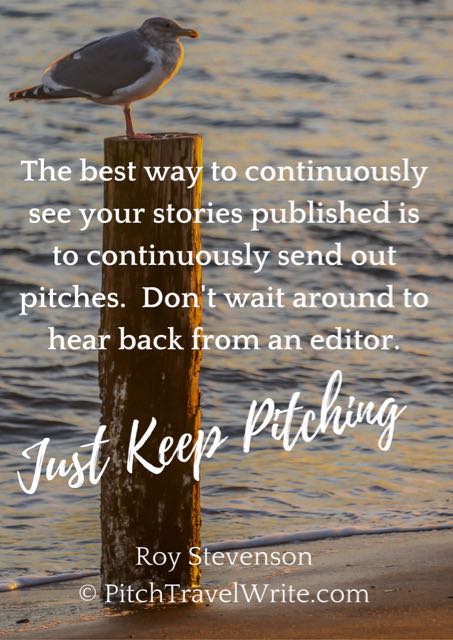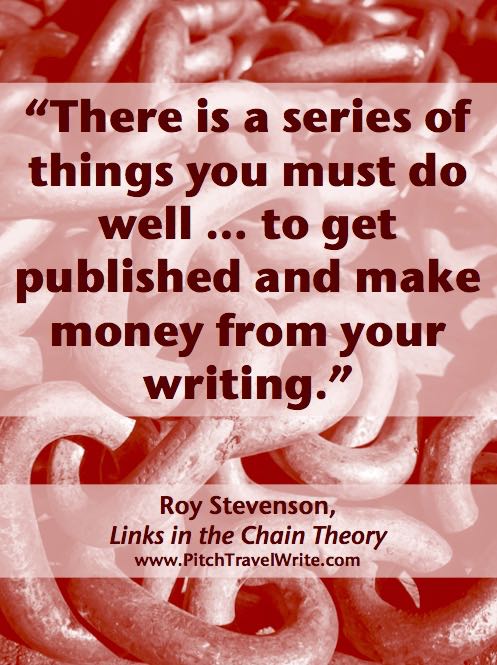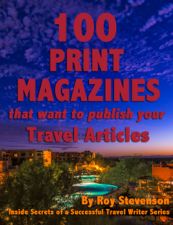- Home
- Getting Published
- Secrets of Successful Travel Writers
Successful Travel Writers
and Their Secrets
... and what to do to up your game
By Roy Stevenson
Successful travel writers get their travel stories published prolifically. I’m always looking at what makes successful freelance journalists tick, so I study their methods.
You might think the more well-published travel writers simply dream up better stories that sell. Or, perhaps they’re better and faster writers than the less-productive ones. Nope - it's none of these.
I've seen many writers come up with plenty of creative, publishable travel story ideas. Most have similar writing abilities and type at about the same speed. In fact, they’re all faster on the keyboard than I am. So that's not it, either.
So I looked elsewhere to answer my question, Why do some travel writers get published more than others?
Successful travel writers do certain things every day. Here's what I found:
Successful travel writers establish a consistent writing routine and stick to it
I noticed the most successful travel writers have one particular writing habit in common. After talking with productive writers, the importance of establishing a consistent writing routine became crystal clear. They have a set time each day when they sit down and write.
Now, this may not seem surprising to some of you. We do know that every successful artist — from painter to glass blower to writer — has to put in regular time at their craft. They don't treat their work as a hobby. It's a job.
I would suggest that the moment a “hobbyist” travel writer suddenly realizes that his or her writing is a job, and starts working to a consistent schedule, is the moment they transcend from being an amateur hobbyist to a professional freelance writer.
I discovered this when I started my freelance writing career. I put in full time work hours straight out of the blocks. This was the result of a high personal motivation. My wife’s instructions were very clear. I had one year to be earning enough to contribute to our monthly grocery bill or “Get a job”. There’s nothing like the fear of working a 9-to-5 job to motivate me to succeed!
Every morning I would sit down and write from 5 a.m. to 7:30 a.m., take a break and eat breakfast, then work steadily until lunchtime. After lunch, I’d continue my writing at this pace throughout the afternoon, and often pick up after dinner and work until 9:30pm.
I allowed no distractions. No music. No TV. No Netflix. No Facebook. And yet, once I got into a routine, I enjoyed every minute of it.
Establish a consistent writing routine and schedule your time and you'll become a successful travel writer. Know what time you “go to work” each day and make sure everyone around you knows your work hours, too. Remove distractions and you’ll be surprised at how much you can get done.
Successful travel writers set weekly goals
Although goal setting is the subject of another post, here’s an overview of how to plan each week:
Start each week with a short list of goals.
Remember that your goals need to be SMART (specific, measurable, achievable, relevant, and time bound). For example, your goals for one week might look something like this:
1) Create magazine distribution list for food-wine-beer genre.
2) Pitch next 3 new story ideas from prioritized list.
3) Write article about the jungle temple.
If your list of goals looks achievable and relevant for one week, you’re ready for the next step.
Break your weekly goals into daily tasks.
Each one of your goals has a set of tasks that needs to be completed. By listing the main tasks and slotting them into a daily task list, you will know what work has to be done each day. You’ll also know that what you’re doing aligns with your goals.
Successful travel writers stay focused on the main goals for the week. Realize that time spent on unrelated tasks will not help you advance. Also, realize that you might not complete all of your goals each week. What’s important is that you accomplished some work toward reaching those goals.
What if you finish all your tasks before the week is over? That’s your choice. Sometimes you can reward yourself and take a day off. Otherwise, if you’re full of energy then pick up another goal or two and get back to work.
Successful travel writers stay focused on their main tasks and don't get distracted
When you’re starting out, building your bylines and credibility, your primary focus should be on the following six core tasks. It’s what I call my Marketing Mastery Links Formula ™:
My Marketing Mastery Links Formula ™ to Sell More Stories:
1. Dream up and develop saleable travel story ideas and angles.
2. Research your topics thoroughly.
3. Create a distribution list to pitch to.
4. Create a solid query letter that resonates with editors.
5. Deliver a quality piece in a timely manner.
6. Develop strong relationships with editors and get repeat business.
Keep in mind that your time spent on the above tasks will vary greatly depending upon where you are in your writing career. Beginners, for example, will spend large amounts of time dreaming up and developing story ideas and then pitching them to magazines.
Successful travel writers, who’ve established regular repeat work with magazine editors will spend more time writing articles as they become part of that editor’s writing stable.
Successful travel writers continuously send out pitches to magazine editors
The unromantic truth behind freelance writing is, that if you want to get your stories published consistently you must establish a consistent writing and querying schedule. There’s no magic or quick fix here.
Successful travel writers pitch continuously. Random writing and querying schedules just won’t cut it. Writers who work sporadically get sporadic results.
The best way to continuously see your stories published is to continuously send out pitches. Don’t wait around to hear from an editor. Find another story idea and just keep pitching!
This has been my mantra since I started writing back in 2007. Back then, when I was trying to generate work, I spent well over half my time preparing and researching story ideas and then pitching them to magazines.
My regular, assembly line pitching and querying always ensured that I had plenty of stories to write. I once had 32 articles stacked up to write for magazines. And I hope you will all have the same ‘problem’ one day!
With this system I always have something to do when I sit down to work every day. And having this focus has made it easy for me to develop a routine.
If you’re serious about your freelance writing, your goal is to constantly be getting assignments into your pipeline. This way you’ll always have work to do. You need to get to the point where you’re writing articles every week so money comes in continuously.
To do this, you need to clearly understand what your most important tasks are, and—equally as important—know the irrelevant, time wasting tasks so you can eliminate them from your schedule. The next section of the article gives some guidelines about how to do this.

Guidelines for Successful Travel Writers:
Scheduling Your Time
Getting distracted will keep you from doing your work every day. Successful travel writers know they must be disciplined if they want to succeed.
You know your personal responsibilities and preferences far better than I do, so schedule your travel writing blocks according to your personal habits and preferences. Here are questions to ask yourself and guidelines to consider:
When are you at your creative best?
You’ll need to find the time of day you’re most productive and when you do your best work. For me, that’s first thing in the morning. This tends to be the best time for many people. Your mind is fresh and your energy is high, so this is usually the best time to write.
Mundane administrative tasks can be done later in the day. These tasks don’t require much creative thought and often can be done on autopilot.
The afternoon, or evening, seem like a good time to be doing your social media posts, catching up on email, and other things that require little energy.
How Long Should You Write?
After fifteen years of freelance writing, I’m comfortable writing in 1-2 hour blocks. However, most novice travel writers can only handle 20-30 minutes before their minds start to wander.
Well-documented studies on high performance indicate that 50-60 minute time blocks with a 10-minute break in between are most effective. Starting out, aim for something in this range. Set your timer and focus on your work for 50-60 minutes. Then take a break.
Your 10-minute break should be active. Get up, drink some water, stretch, play with your dog, cuddle your cat, or walk around your garden. You’ll go back to work refreshed and ready for the next block.
Stack up 3-4 focused blocks of time each day (with breaks) during your most creative time of the day and you’ll soon find yourself accomplishing a lot.
Take Plenty of Breaks
Regardless of the length of your writing blocks, always make sure you schedule plenty of breaks between your blocks of writing.
At a recent travel writers workshop our presenter, a professional author, recommended that we set our iPhone timer to ring when our creative writing block has ended, and then take a break.
You can also use something as simple as a kitchen timer, or get fancier with time management apps to help you. Just don’t let your tools get in the way. The objective is to write and take breaks, so use whatever works to stay on task.
Are You a Professional or a Hobbyist?
Knowing the answer to this question helps you understand how much time you need to devote to your travel writing craft. It also helps to define where to get published depending upon whether or not you want to get paid for your work.
The definition of a professional: a person who devotes a significant amount of time to her/his work each day and who depends on getting paid for that work as a source of income. Most successful travel writers fall into this camp.
Hobbyists on the other hand aren’t concerned about getting paid. They’re often happy earning “coffee money”. If you’re a hobbyist you might still spend a lot of time writing if you’re enthusiastic about the craft. But you have more flexibility about how much time to spend on it, and where to get published. For example, hobbyists are more likely to write for free because they don’t depend upon writing as a source of income.
How many hours you spend working each day will vary with your goals. If you want to get published in print and get paid for your work on a regular basis as a professional, you’ll need to treat it like a full-time job. Your actual writing time will vary as you evolve as a writer. At the beginning you’ll do more pitching than writing. Later, after you know how to land assignments, you’ll do more writing.
Incidentally, about 80-90% of people who call themselves travel writers are hobbyists. Whether you’re a professional or a hobbyist doesn’t matter. It doesn’t define your writing capabilities. Many hobbyists are excellent writers and I’ve learned a lot about the freelance writing game by talking shop with them.
Universal Time Wasters
Waiting. Many novice travel writers send out a group of query letters to magazines and tend to sit back and wait to hear back from the editors. If you do this, you'll spend a lot of time spinning your wheels, being unproductive. The idea is to be continuously sending out pitches to land assignments.
Social media is another chronic time waster. It’s so easy to be swept away on the social media tsunami! Whether you spend time on Facebook, Pinterest, Instagram, Twitter, or any other social media platform – they will all kill your time.
I say this from personal experience. If you’re spending more than 30 minutes/day on social media, you’re wasting valuable time that is far better spent doing the six main travel-writing tasks listed above. Leave the “look at me” social media vanity posts to others who are not as dedicated or committed to their writing as you.
As I’ve mentioned in a previous post, social media will NOT provide you with writing assignments from magazine editors. Dreaming up saleable story ideas and sending out query letters is what rakes in the paying work.
Checking email and/or texting throughout the day, watching TV, and Netflix are also time wasters if you’re doing these things when you should be doing your work.
What are the things that distract you from your work? Make a list and then figure out a way to control them so they don’t take over your day.
Successful travel writers take back their time and focus on what is important to them
How do you spend your time each day? Stop giving up your life to distractions and nonsense.
If you want to be a travel writer (or anything else in life) then keep a consistent schedule and stay focused on the specific and direct tasks that will help you reach your goals.
By doing these things, you’ll be more productive. You’ll have more energy. And you’ll reach levels of success with your freelance travel writing you never dreamed possible.
Break into Travel Writing
with the Creative Pack
The Creative Pack includes 3 eBooks that are the starting point for every travel writer: dreaming up unique story ideas that you can sell, finding the best writing niches for you based on your interests, passions and experience, and the art & craft of travel writing. They’re the pieces of the puzzle that come before you ever write a query letter to sell your articles to magazine editors.
If you're just getting started in travel writing, this group of resources will help you improve your craft, generate story ideas that sell, and develop your own unique and meaningful niche.
These eBooks can be purchased separately, but when you buy the bundle you'll save more than 10% off individual prices! Learn more here ...

Roy Stevenson is a professional travel writer and the author of www.PitchTravelWrite.com. Over the past ten years, he’s had more than 1000 articles published in 200 magazines, trade and specialty journals, in-flights, on-boards, blogs and websites and has traveled on assignment around the U.S. and to dozens of international destinations.
IF YOU ENJOYED THIS POST, GET UPDATES. IT'S FREE.


















